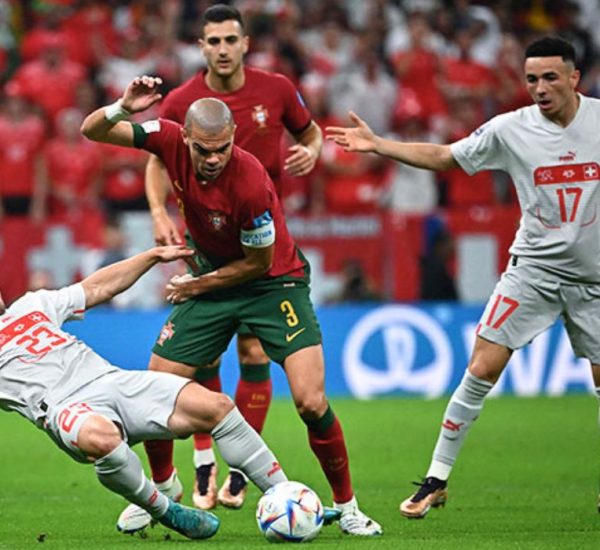The Laws of Soccer stipulate that goalkeepers cannot score with their hands. This rule was implemented to prevent goalkeepers from taking advantage of the field and scoring goals against their opponents.
But there have been instances when a goalkeeper has made an unforced error and scored an impressive goal, widely celebrated by fans and the media alike.
Free Kicks
A free kick is a chance for a soccer team to restart play after an opponent commits foul or unsportsmanlike behavior. Examples of such actions can include charging another player off the ball, dissent between a player and an official, or making offensive gestures.
A referee marks the spot where a foul occurred, and then the kicking team sets the ball down. Furthermore, the defending team must be at least 10 yards from where the ball is being taken.
Regarding free kicks, there are two distinct categories: direct free kicks and indirect free kicks. When the referee decides which type of free kick should be awarded, several factors must be considered.
One of the most critical things to remember when taking a free kick is to aim straight. This is because goalkeepers can be very quick on their feet, so he may need more time to react to your kick if you aim it straight downfield. By doing so, your ball will travel directly where you intend it to go.
Additionally, aim to make contact with the ball in the center of your laces. Doing so will give your kick more power and enable it to travel faster.
Finally, strive to practice your free kicks frequently so you become proficient at making them accurate. This could be done by shooting over a wall or training with an experienced teammate who is good at shooting.
Once you feel secure in your technique, tell your teammates that you are willing to take a free kick as soon as the foul occurs. Doing this will enable you to score more goals and become an even better player.
You can practice taking shots from various positions. Crosses, which are weaker than direct shots but still effective, are one example.
Becoming an excellent goalkeeper requires knowledge of how to take free kicks and other fouls. These can be great chances for you to score, so ensure that you feel confident during this process and don’t hesitate to ask for a chance when necessary.
Throw-Ins
Throw-ins are a basic but essential skill in soccer that can drastically shift the game’s dynamic. After losing possession of the ball or earning a free kick, teams can restart play with ease; however, certain rules must be observed in order to take it correctly.
First, the player taking the throw must face the field of play with at least part of their foot on or outside of it. They then raise the ball over their head and grasp it securely with both hands.
Once a player takes a throw-in, they cannot enter the soccer field until both sides of them have touched the ball. This rule was put in place to prevent anyone from gaining an unfair advantage by entering while a throw-in is in progress.
Another essential rule to remember is that goalkeepers cannot score directly from throw-ins. This is because the ball is too high for them to kick, and they cannot pick up a ball thrown to them from such a restart.
If a player fails to abide by this rule, they could receive a yellow card and their throw-in ruled as a foul, giving the opposition team the advantage of scoring a goal and regaining possession of the ball.
Soccer offers two methods of taking a throw-in: running throw or drag foot. Running throws are ideal for shorter passes and keeping the ball away from defenders.
Throwing the ball correctly can be challenging, but with practice you will master the correct technique. Once you feel confident with your throw-in throw, practice with a soccer ball to perfect the throw-in motion.
A great way to practice this skill is by having your teammates stand shoulder-to-shoulder and pretending they are making a throw-in on “go”. Once they become comfortable with this technique, it’s time for them to try it with a soccer ball. Doing so will allow them to become familiar with the weight and size of a soccer ball while honing their throw-in techniques.
Penalty Kicks
Catching a penalty kick is one of the most thrilling moments in soccer, as it often determines the outcome. These kicks are awarded when an offense takes place within the penalty area – that area marked on the field that extends 16.5 metres (18 yards) from each goalpost and 16.5 metres deep.
Penalty kicks are the most frequent way to score in soccer, but they can also be used as a means of breaking a tie or even winning the game. The referee will signal a penalty kick by blowing their whistle and pointing towards the penalty spot.
Before taking a penalty kick, all players on the opposing team must stand outside the penalty arc – a D-shaped field section extending 12 yards from each goal. This arc keeps opponents from getting too close to the kicker, who must remain at least 11 meters (12 yards) away from the ball.
Once the ball is on the penalty spot, only one person may touch it: the kicker. They must remain at the spot until it is kicked.
The referee will then blow their whistle, allowing the kicker to take advantage of a penalty kick. Players must kick it forward toward the goalkeeper, who can either wave their arms or jump to distract them.
If the goalkeeper commits an offense during a penalty kick, they will be cautioned, and the kick will be recorded as missed. If multiple offenses are committed during one penalty kick, they are sent off for good measure.
In a 1-1 tie, New York Red Bulls midfielder Lewis Morgan was jostling for possession inside the penalty box when New England Revolution’s Thomas McNamara dragged him down. After consulting his aides, referee Michael Bennett awards Morgan with a penalty kick.
To be a successful penalty kicker, you need good technique and the ability to manage your nerves. Practice these skills regularly, so they become second nature when using them on the field.
Goal Kicks
Scoring a goal in soccer can be done in several ways, but one of the most popular is a goal kick. Whether you are the keeper or playing as the striker, here are some tips on making the most of your shot at scoring a goal.
Before anything else, it’s essential to understand that a goal kick can only be awarded when the ball has crossed over without any involvement from any member of the attacking team. This type of kick is known as a direct kick, meaning no passes or touches are necessary before it leaves the field.
Referees use this rule (also called the “rule of thumb”) to determine when the ball has left the field and must be restarted. Furthermore, no defender must touch the ball while it remains within the penalty area.
Typically, the goal kick is taken by a player on the attacking team to create space for other players on the field. That player may then use the ball to advance their team upfield or even pass it directly to someone closer to their end of the field.
Another situation when goal kicks can be utilized is when the attacking team finds itself behind its goal. This gives them a great chance to capitalize on long passes deep within their opponent’s half.
Goal kicks can be taken anywhere along the goal line, but placing the ball two or three yards inside of play is most effective. Defending teams must stand outside their goal area until the ball enters play.
Goal kicks are a valuable weapon for attacking teams to use to increase their scoring chances. But teams must adhere to specific regulations for a goal kick to succeed; otherwise, you could forfeit your kick and the game.



